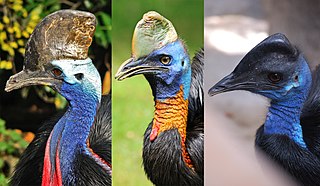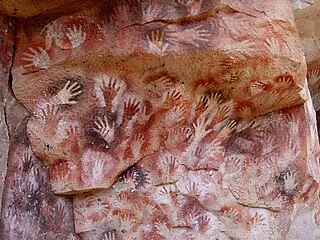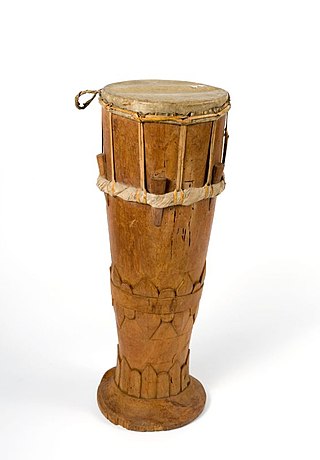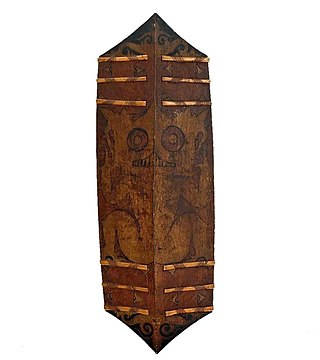
Cassowaries are flightless birds of the genus Casuarius in the order Casuariiformes. They are classified as ratites: flightless birds without a keel on their sternum bones. Cassowaries are native to the tropical forests of New Guinea, the Aru Islands (Maluku), and northeastern Australia.

In archaeology, cave paintings are a type of parietal art, found on the wall or ceilings of caves. The term usually implies prehistoric origin, and the oldest known are more than 40,000 years old and found in the caves in the district of Maros. The oldest are often constructed from hand stencils and simple geometric shapes. More recently, in 2021, cave art of a pig found in Sulawesi, Indonesia, and dated to over 45,500 years ago, has been reported.

The culture of Indonesia has been shaped by long interaction between original indigenous customs and multiple foreign influences. Indonesia is centrally-located along ancient trading routes between the Far East, South Asia and the Middle East, resulting in many cultural practices being strongly influenced by a multitude of religions, including Buddhism, Christianity, Confucianism, Hinduism, and Islam, all strong in the major trading cities. The result is a complex cultural mixture, often different from the original indigenous cultures.

Michael Clark Rockefeller was a member of the Rockefeller family. He was the son of New York Governor and former U.S. Vice President Nelson Rockefeller, a grandson of American financier John D. Rockefeller Jr. and a great-grandson of Standard Oil co-founder John D. Rockefeller Sr.

The word zoomorphism derives from Ancient Greek: ζωον, romanized: zōon, lit. 'animal' and Ancient Greek: μορφη, romanized: morphē, lit. 'form; shape'. In the context of art, zoomorphism could describe art that imagines humans as non-human animals. It can also be defined as art that portrays one species of animal like another species of animal or art that uses animals as a visual motif, sometimes referred to as "animal style." In ancient Egyptian religion, deities were depicted in animal form which is an example of zoomorphism in not only art but in a religious context. It is also similar to the term therianthropy; which is the ability to shape shift into animal form, except that with zoomorphism the animal form is applied to a physical object. It means to attribute animal forms or animal characteristics to other animals, or things other than an animal; similar to but broader than anthropomorphism. Contrary to anthropomorphism, which views animal or non-animal behavior in human terms, zoomorphism is the tendency of viewing human behavior in terms of the behavior of animals. It is also used in literature to portray the act of humans or objects with animalistic behavior or features. The use of zoomorphism served as a decorative element to objects that are typically quite simple in shape and design.

The southern cassowary, also known as double-wattled cassowary, Australian cassowary, or two-wattled cassowary, is a large flightless black bird, found in Indonesia, Papua New Guinea, and northeastern Australia. It is one of the three living species of cassowary, alongside the dwarf cassowary and the northern cassowary. It is a ratite and therefore related to the emu, ostriches, rheas and kiwis.

A Bisj, mbis or Bis pole is a ritual artifact created and used by the Asmat people of south-western New Guinea, Indonesia. Bisj poles can be erected as an act of revenge, to pay homage to the ancestors, to calm the spirits of the deceased and to bring harmony and spiritual strength to the community. Bisj poles are a type of wooden ancestor pole among the Asmat of the province of South Papua, Indonesia. Figures of the dead are stacked along the pole, and a phallic symbol of fertility and power is included. The poles were traditionally carved to accompany the feast after a headhunting raid, and although headhunting is no longer practiced, the bisj tradition continues to the present time as a customary practice to honor deceased members of a village.

The Asmat are an ethnic group of New Guinea, residing in the province of South Papua, Indonesia. The Asmat inhabit a region on the island's southwestern coast bordering the Arafura Sea, with lands totaling approximately 18,000 km2 (7,336 mi2) and consisting of mangrove, tidal swamp, freshwater swamp, and lowland rainforest.

The art of the Upper Paleolithic represents the oldest form of prehistoric art. Figurative art is present in Europe and Southeast Asia, beginning between about 40,000 to 35,000 years ago. Non-figurative cave paintings, consisting of hand stencils and simple geometric shapes, are somewhat older, at least 40,000 years old, and possibly as old as 64,000 years. This latter estimate is due to a controversial 2018 study based on uranium-thorium dating, which would imply Neanderthal authorship and qualify as art of the Middle Paleolithic.

HaYonim Cave is a cave located in a limestone bluff about 250 meters above modern sea level, in the Upper Galilee, Israel.

Kundu is a pidgin name in Papua New Guinea for an Hourglass drum used to accompany formal occasions, religious ceremonies and for celebrations. This drum is emblematic of Papua New Guinea and it appears on the country's coat of arms.

Alphonsus Augustus Sowada was an American Roman Catholic bishop, cultural anthropologist, and first Bishop of Agats in Indonesia. A longtime collector and preserver of Asmat cultural artifacts, he helped found both the Asmat Museum of Culture and Progress in Agats, and the American Museum of Asmat Art in his home state of Minnesota.

Sewar refers to a dagger of Indonesian origin, typically carried in a belt and used mainly in Sumatra, Indonesia. The blade is also referred to as Sewah by the Gayo people, Seiva by the Minangkabau people, Siva by the Alas people, and Siwaih by the Acehnese people.

Agats is a town in Asmat Regency, South Papua, Indonesia. An elevated settlement on a tidal plain, a Dutch outpost was set up in Agats in 1938 and the town became notable for the cultural practices of the Asmat people. Following the formation of Asmat Regency in 2002, the town became its administrative seat.

It is quite difficult to define Indonesian art, since the country is immensely diverse. The sprawling archipelago nation consists of 17.000 islands. Around 922 of those permanently inhabited, by over 1,300 ethnic groups, which speak more than 700 living languages.

The American Museum of Asmat Art is a gallery exhibiting the art and culture of the Asmat people of southwestern Papua, Indonesia, housed at the University of St. Thomas in St. Paul, Minnesota. Featuring more than 2,200 objects, it is one of the largest of its kind in the United States. Asmat art is widely collected in major Western museums despite the difficulty in visiting the remote region to collect work; the "exceptionally expressive" art "caused a sensation in art-collecting circles" which led to large-scale collecting expeditions in the post-WWII era, according to art scholar and ethnology Dirk A.M. Smidt. The gallery includes a permanent display of Asmat works such as ancestor poles (bis) and canoes, and a rotating exhibition highlighting aspects of Asmat art and culture. Much of the collection is accessible through the museum's online database.
The Brazza River is a river in Papua province, Indonesia. The Brazza River has its source at over 3000 meters of elevation in the Jayawijaya or Maoke Mountains of central Papua in Yahukimo Regency, and flows south to the lowland rainforests of Asmat Regency before meeting the Pulau River, which flows southeast to the Arafura Sea.

Otsjanep or Ocenep is a village in Asmat Regency, South Papua, Indonesia. The village is located on the bank of the Ewta river at the far north end of Indonesia's Casuarina Coast, named for its casuarina trees but now disappearing due to logging. Otsjanep is renowned for its wood carving. The locals continue to wear traditional clothes, but the village has a modern missionary church and – unusual in this area – grass lawns.

The tifa, tiwa or tiva is a single-headed goblet drum used throughout the Maluku Islands of Eastern Indonesia, where it is traditionally the "dominant instrument" in Maluku province music. The term tifa has been used outside of the Maluku Islands, including on the island of Java and on the island of New Guinea, in Indonesia's Papua province.

The Kliau, Keliau or Klau is a traditional shield of the Dayak people of Borneo. It is similar to the shields used by other Dayak people such as the Klebit Bok of the Kenyah. Other names for this shield include: klawang or kelawang and trabai or terabai.






















